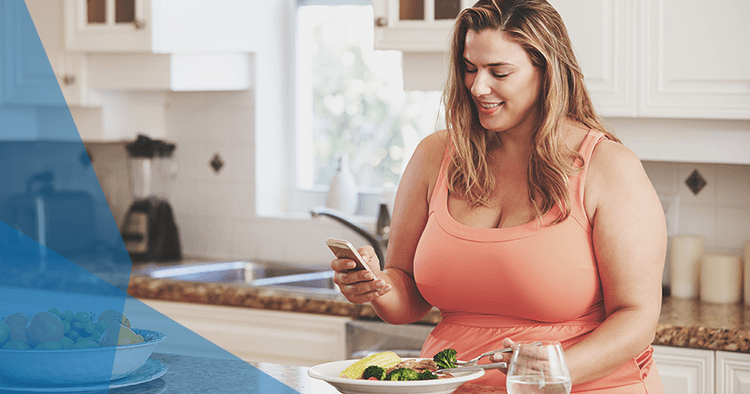Trainers are great at making dietary meal plans.
I used to think I was the Don of Diets, and could craft the perfect meal plan to get any client lean and shredded in record time. In theory at least.
Even overlooking the fact I used to be the ultimate clean eater/ bro/ Paleo enthusiast before discovering flexible dieting and tracking calories and macros, my diet plans would still work if the client stuck to them.
They were high in protein, calorie-controlled, contained a decent amount of carbohydrate and fat so the client wouldn't feel like they were suffering too much, and had a wide range of foods.
Ergo - if followed, each individual client would reach their goals, no doubt about it.
I set up my diets to bring about success.
But here's the deal -
Your dietary plan can be "perfect" on paper, but if a client won't follow it, it will never deliver results.

We assume that every client is just as dedicated, disciplined and motivated as us. That they'll happily put their lives on hold to achieve results, and have their goals and progress at the forefront of their minds the whole time ... not the case.
My issue was giving my clients diets plans that, while effective, would never work, as they'd never be followed.
So, that leaves us with the question -
"What are the diet strategies they'll actually follow?"
Here are my top five dietary meal plan strategies from my 7 years as both an in-person and online coach.
5 Diet Plan Strategies That Your Client Will Actually Follow
1. Make it Easy ... Like TOO Easy
This is less of a diet strategy, and more just a general piece of advice.
Think of a goal you'd find easy, and work backwards.
Make it so easy, your client couldn't possibly fail to achieve it.
The Precision Nutrition tip of advising your client to take a fish oil or a multivitamin every day is a great one.
Editors Note: PN recently reversed their stance on fish oil for every client. We still feel like giving an easy first step to begin to establish a habit is a good one so decided to leave this piece of advice as-is just know that fish oil may not be the best choice.
Why?
Well, because it requires so little effort.
All your client needs to do is leave a bottle on their kitchen counter, or in their desk at work.
Popping that pill will have absolutely no direct affect on fat loss whatsoever, but it gets them into the habit of making positive changes.
Plus it's important to remember that the vast majority of your clients will have come to you because they've "failed" at dieting time and time again. They're so used to under-achieving, that getting to the end of a week having perfectly met their goal is a big deal.
Mentally, it's a huge step, and sets them up for moving ahead and creating bigger, more effective habits.
As the trainer, you could make this even easier for them by sending them a text every evening just saying -
"Fish oil/ multi?"
Time commitment to you = minimal
Chances of client success = almost guaranteed.
2. The "30 in 30" Rule
I picked this one up from Tim Ferriss
Okay, he's not exactly a dieting expert, or the font of all nutritional knowledge, but this tip is golden, and it's so simple:
- Eat 30 grams of protein within 30 minutes of waking
That's it.
I found that once I set clients off doing this, so much fell into place, even though I didn't tell them to do anything else.
We all know that protein is satiating, and considering the average person's breakfast contains virtually no protein whatsoever, this introduction of protein makes them feel incredibly full, and eradicates mid-morning mindless snacking.
For some folk, the "30 in 30" might be a little too much. After all, 30 grams of protein is a scoop and-a-half of whey, 4 eggs, or 12 oz of Greek yogurt, so I prefer a "20 in 20" rule.
Don't just tell your clients this though - remember, they more than likely don't have the first idea what 20 grams of protein even looks like.
So give them a list -
- 1 scoop of protein mixed in water
- ½ a scoop of protein mixed in milk
- 8 oz of yogurt or cottage cheese
- 3 eggs
- A protein pancake made with 1 whole egg, 2 egg whites, ½ a scoop of protein and a banana.
- A protein bar
Introduce this as their goal in week 2 or 3.
They should keep going with the fish oil/ multivitamin, but add this in too.
Don't ask them to do anything else - both you and they might be surprised at the extent of the progress that comes about from 30 in 30 or 20 in 20.
3. Get Snap Happy
Food logs and diaries are awesome.
But here's where they fall down -
a) People are busy, and often won't fill in their log until the end of a day, by which time they've forgotten what they've eaten
b) Writing stuff down, in today's tech-savvy age, is a little boring, and it's easy to get off track and miss a few days.
That's why I prefer clients to take pictures of their food.
They love doing this.
A visual representation is far more useful to both of you.
As the trainer, it lets you see the quantities your client is consuming (as, let's face it, most folk won't be too amenable to weighing out servings of broccoli, and one person's "handful" of pasta is very different to the next.)
Second, it really makes the client think about what they're eating too.
Suddenly, "Donut Dave" realizes that maybe there's a reason for his nickname, while Linda, who always asks for "just a small skinny caramel latte" notices that perhaps those 200-calorie drinks she thinks are innocent enough start to add up when she downs four every day.

You might also get funny pictures sent to you of people like Rog Law trying to figure out chopsticks as JC Deen looks on.
4. Beat My Streak
As a flexible dieting advocate, I do love tracking calories and macronutrients.
But it's not for everyone.
Not every new client needs to track to make progress - they'll see physical changes simply from adopting new healthy habits, but at a certain point, getting a little more precise with monitoring is needed.
It's here when I introduce tracking - usually with MyFitnessPal.
You can do this one of two ways though -
Option #1 -
You:
"Right Debbie.
So there's this website where you have to go sign up, put in all your details so that it tells you exactly how many calories you need per day, and the precise amount of protein, carbohydrate and fat to consume.
These calculations are garbage though, so we'll use some numbers I give you instead.
Once you've gone through the pointless 15-minute process of setting everything up, then ignoring their recommendations and using mine instead, you're going to have to manually enter every single thing you eat and drink, every single day for the rest of your life, to make sure you hit those numbers.
Got it?"
... Hardly sounds too appealing, does it?
Why not try it like this -
Option #2 -
You:
"Debbie you've made some awesome progress so far, but how about we step things up a notch and help you lose fat even faster?
There's this website and app - MyFitnessPal - where you can simply scan the barcodes on food packages, input how much you eat, and it tells you exactly what you're consuming every day.
It might take you a few minutes to get going, but it's really simple once you're into the swing of things.
We'll make it easy too - I'll give you a calorie range to hit every day, and we'll aim for a certain amount of protein, and that's it.
Plus, I always challenge clients to beat my streak of consecutive days logging - you up for the test?"
With this option, you're almost making it a game.
You can secretly build in a "buffer" of a couple of hundred calories and tell clients that vegetables are "free foods" so that they don't stress over the calories in spinach or cauliflower.
I like having a prize for the most consistent tracker too - something like tickets to the cinema, or vouchers for a meal at a local restaurant.
Just a quick one on the calorie/ protein:
While a macro calculator might tell you that your client needs exactly 2,175 calories, 186 grams of protein, 63 grams of fat and 216 grams of carbs, few clients will ever even try to stick to this.
Again, it's on YOU to make it easier.
How about telling them to shoot for 2,050 to 2,250 calories, and a minimum of 160 grams of protein?
That'd still get great results, but give them so much more leeway, flexibility and enjoyment.

5. Meal Plans vs. Macros
5 years ago, every single trainer would give a client a meal plan
07:00 - 6 egg whites, ½ cup of oats made with water, 1 scoop greens supplement
09:30 - 2 scoops of whey protein, 1 medium orange, 1 oz almonds
That kind of thing.
Now, it seems we've gone full circle, with many trainers refusing to give meal plans, and instead insisting that every client tracks macros. When a question crops up like:
"I have 25 grams of protein, 15 grams of carbs and 15 grams of fat left - what can I eat?"
Inevitable, smart-ass trainers come in with one of two answers -
- "Whatever fits your macros"
- "Food"
Unfortunately, neither of these is much use whatsoever to your client who still hasn't quite got their head round calories and macronutrients, or who's spent years yoyo dieting.
Instead, I've found a blend of the two approaches to be much more effective.
The calorie range and protein minimum as per tip #4 is great, but how about knocking up a few sample meal plans for your clients, too?
We're not talking the 1980s bodybuilding magazine-esque strict, regimented diets with meals every few hours, and exact recommendations, rather something like -
Dinner:
- 1 of - 1 large chicken breast, 1 large salmon fillet, 8 oz rump steak or 8 oz ground turkey.
- 3 cups of any green vegetable
- 1 serving of starch. This equals a cupped handful of any type of rice, pasta, couscous or quinoa (uncooked) or 2 slices of bread, or 1 medium potato or sweet potato.
- Add a tablespoon of oil or butter, salad dressing, mayo, ½ a medium avocado or 1 oz of nuts if you want for one of the leaner protein options - i.e. the chicken or turkey.
Lunch options can be a godsend for your busy office worker clients too.
Ask them what they have local to them, and give them a tonne of options -
- McDonalds - grilled Southwest, Ranch, or sweet chilli chicken wrap, with a side salad or apple slices and any diet drink, Americano or skinny cappuccino.
- Subway - 6" turkey, turkey and ham, chicken breast or steak. Or any of these as a salad, plus a bag of Baked Lays.
- Chipotle - any bowl with cheese OR sour cream, or 3 tacos (any filling but no cheese) or a salad with everything in.
Again, you're encouraging flexibility and choice, but giving guidance at the same time.
This gets your clients thinking for themselves, and taking on some accountability, yet they know you're there, in their corner, helping them out too.
What Can YOU Do?
Whether you're a newbie trainer, or a seasoned vet, we can all take a look at how we currently work with our clients' nutritional needs and the strategic meal plans we design for them.
Too many trainers jump into defensive mode, and operate a "My way or the highway" policy - expecting clients to make radical changes to their diet and lifestyle overnight, deeming them noncommittal if they don't.
The cold hard truth though, is that the vast majority of the general public simply can't do this, and therefore, it's up to you, as the trainer, to make things as straightforward as possible, to increase adherence, and get them the results they desire.
Try this ...
- Make a list of all your current clients
- Separate them into 3 categories - those who need very little assistance from you, those who are really struggling, and those who are somewhere in the middle.
- Your top tier guys and girls probably don't need too much from you - why not send them a text or an email right now just to see how everything's going?
- Your middle folk - they likely need a quick analysis of their food diary, so maybe have a chat with them in their next session, and book this in for a week's time?
- As for the clients you have who are struggling - ring them up. Tell them you've been doing some thinking, and have some highly effective, very simple ways you can help them out with their diet, and would like to chat through these."¨Next session - forget the bench presses and burpees, and sit down with them for a chat instead."¨Go back to basics, and run these 5 points through, going as slow and steady as they need to.
Getting your clients from where they are now to where they want to be will rarely (if ever) be a linear process, and it certainly isn't smooth sailing.
But you can make that journey a lot easier, and a lot more enjoyable for them with simple, actionable steps.
Further Reading
Help! My Clients Won't Follow My Nutrition Advice - Jonathan Goodman










